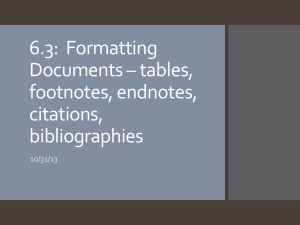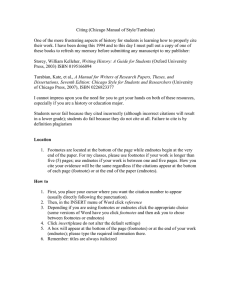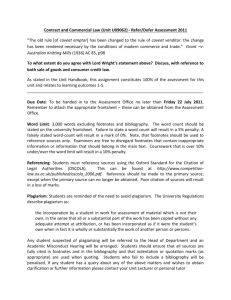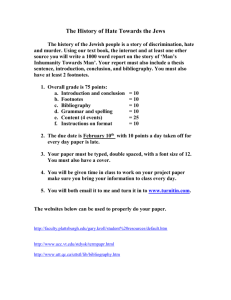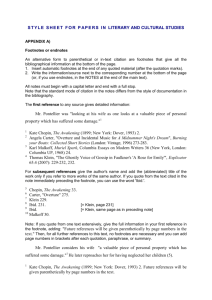A. Basic Format Requirements B. Documentation: Notes and
advertisement
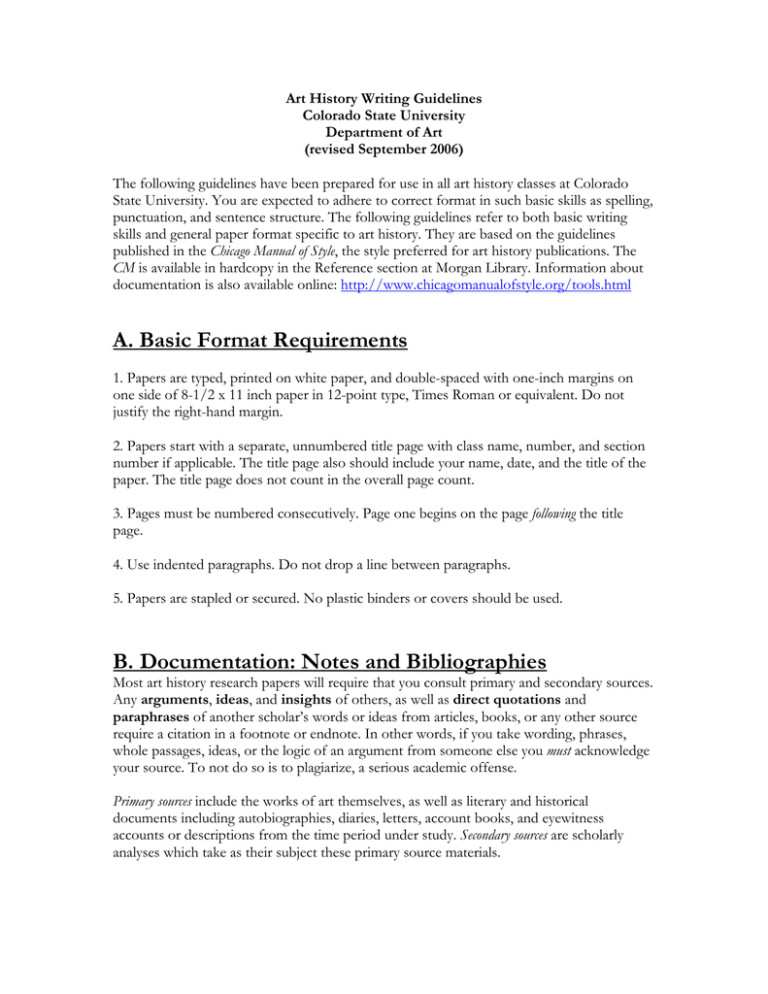
Art History Writing Guidelines Colorado State University Department of Art (revised September 2006) The following guidelines have been prepared for use in all art history classes at Colorado State University. You are expected to adhere to correct format in such basic skills as spelling, punctuation, and sentence structure. The following guidelines refer to both basic writing skills and general paper format specific to art history. They are based on the guidelines published in the Chicago Manual of Style, the style preferred for art history publications. The CM is available in hardcopy in the Reference section at Morgan Library. Information about documentation is also available online: http://www.chicagomanualofstyle.org/tools.html A. Basic Format Requirements 1. Papers are typed, printed on white paper, and double-spaced with one-inch margins on one side of 8-1/2 x 11 inch paper in 12-point type, Times Roman or equivalent. Do not justify the right-hand margin. 2. Papers start with a separate, unnumbered title page with class name, number, and section number if applicable. The title page also should include your name, date, and the title of the paper. The title page does not count in the overall page count. 3. Pages must be numbered consecutively. Page one begins on the page following the title page. 4. Use indented paragraphs. Do not drop a line between paragraphs. 5. Papers are stapled or secured. No plastic binders or covers should be used. B. Documentation: Notes and Bibliographies Most art history research papers will require that you consult primary and secondary sources. Any arguments, ideas, and insights of others, as well as direct quotations and paraphrases of another scholar’s words or ideas from articles, books, or any other source require a citation in a footnote or endnote. In other words, if you take wording, phrases, whole passages, ideas, or the logic of an argument from someone else you must acknowledge your source. To not do so is to plagiarize, a serious academic offense. Primary sources include the works of art themselves, as well as literary and historical documents including autobiographies, diaries, letters, account books, and eyewitness accounts or descriptions from the time period under study. Secondary sources are scholarly analyses which take as their subject these primary source materials. 1. Notes: Footnotes and Endnotes • • • Footnotes are placed at the bottom of the page where the citation is made. Endnotes are listed on a separate page that follows the last textline of your paper, and precede the bibliography. Endnotes are double-spaced between entries, flush left. Choose one or the other. Either form is acceptable (unless otherwise stipulated by your professor). a. Format: Footnote or endnote numbers in your text must be consecutive and indicated in superscript (a raised number: 5 ) in your text. The note number usually comes after the final punctuation of the sentence. Do not drop a line between footnotes/endnotes, and do not add extra space before and after footnotes/endnotes. Microsoft Word does all the formatting for you. If you unfamiliar with Word’s program, please be sure to familiarize yourself with it before beginning to add in your notes. For example: As Franz Marc wrote, “It is like a premonition of this war, horrible and shattering. I can hardly conceive that I painted it.”1 (Later he would write about this quite differently.)2 b. Annotated footnotes (content footnotes) are used to give additional information that is not essential to the thesis of your paper and might detract from the flow of the argument, but that is still important enough to refer to. Use these judiciously, as they can be distracting to the reader. c. Abbreviations: The following abbreviations are commonly used in art historical footnotes: trans. for translated by, ed. for edited by, exh. cat. for exhibition catalogue, rpt. for reprinted. d. Sample note formatting: The very first reference to a source is cited in full. Subsequent references to that source are then shortened (see discussion below). Please take careful note of punctuation! Books: 1 Carl Woodring, Nature into Art: Cultural Transformations in Nineteenth-Century Britain (Ithaca, N.Y.: Cornell University Press, 1989), 23. 2 Stephan Lackner, Max Beckmann (New York: Harry N. Abrams, 1991), 56. Journal Articles: 3 Timothy O. Benson, “Mysticism, Materialism and the Machine in Berlin Dada,” Art Journal 46 (Spring 1987): 49. 4 Richard Bolton, “Art as Education,” New Art Examiner 20, no. 5 (January 1993): 12. [[Note that for journal articles, page numbers in the footnote or endnote citation refer to the specific page cited; in the bibliography, page numbers are inclusive of the entire article.]] Chapter in an edited volume: 5 Eduardo Matos Moctezuma, “Sahagún and the Ceremonial Precinct of Tenochtitlan,” in Representing Aztec Ritual: Performance, Text, and Image in the Work of Sahagún, ed. Eloise Quiñones Keber (Boulder: University Press of Colorado, 2002), 49. Exhibition catalogue: 6 Sidra Stich, Made in U.S.A.: An Americanization in Modern Art, the ‘50s and ‘60s, exh. cat. (Berkeley: University of California Press, 1987), 157-158. Annotated or content footnotes: 7 Stan Brakhage, “Metaphors on Vision,” Film Culture, no. 30 (1963), 120. Brakhage wrote this essay as early as 1960. Viola discovered the films of Brakhage, Hollis, Frampton, Michael Snow, and others while he was a student at Syracuse. 8 See Stephen Bann, Paul Delaroche: History Painted (Princeton, N.J.: Princeton University Press, 1997), 118, who notes Delaroche’s attempts at reform of the Salon jury system which failed in 1834 and, again, in 1836. He resigned from the Salon jury, as did Horace Vernet. Electronic sources: 9 Hugh Elton, “Byzantine Warfare,” Warfare in the Ancient World, 4 April 1999, (accessed 23 April 1999). <http://shakti.trincoll.edu/~helton/army.html>. (Please note: Your computer program may automatically underline the website address, so either use the underline or use < > to indicate the site address. Also, the first date is the day the site was created or last updated, and the last date is the day you used the site.) Shortened citations in footnotes and endnotes: The first reference to a source in footnotes/endnotes gives the entire citation (see above). Subsequent references may be shortened to just the author’s last name, followed by a comma and the page reference. If you are citing more than one work by a given author, you must also use a shortened title in the subsequent references. Also, please refer to the section below for proper use of “Ibid.” Book shortened for subsequent citation: Lackner, 57. or: 11 Lackner, Beckmann, 57. [[if using more than one work by Lackner]] 11 Article shortened for subsequent citation: Bolton, 14-15. or: 12 Bolton, “Art as Education,” 14-15. [[if using more than one work by Bolton]] 12 Chapter in edited volume shortened for subsequent citation: 13 Matos Moctezuma, 30-31. or: 13 Matos Moctezuma, “Sahagún and the Ceremonial Precinct,” 30-31. [[if using more than one work by Matos Moctezuma]] Proper use of Ibid.: You may use “Ibid.” for subsequent references to a single work, only when the information to be cited is the same as in the preceding note and there is no other intervening reference. The Chicago Manual of Style stipulates: [16.47] “Ibid. (from ibidem, ‘in the same place’) refers to a single work cited in the note immediately preceding (but see also 16.48). It must never be used if the preceding note contains more than one citation. It takes the place of the name(s) of the author(s) or editor(s), the title of the work, and as much of the succeeding material as is identical. If the entire reference, including page number(s) or other particulars, is identical, the word ibid. alone is used.” For example: 1 Carl Woodring, Nature into Art: Cultural Transformations in Nineteenth-Century Britain (Ithaca, N.Y.: Cornell University Press, 1989), 23. 2 Ibid. [“Ibid.” is used here for a reference that is absolutely identical to the preceding note.] But: if the page number changes, but the rest of the citation is identical, include the page number after ibid: 2 Ibid., 25-27. [and note punctuation: ibid. takes a period.] 2. Bibliography All sources cited in notes must also be listed in a separate bibliography attached to the end of the paper. The bibliography is attached at the end of your paper. Format: The bibliography is single-spaced with one blank line between entries. The first line of each entry is flush left, and any run-over lines are indented five spaces. The bibliography is alphabetized by author’s last name. Special problems may be solved by observing the following principles: • A single-author entry comes before a multi-author entry beginning with the same name. • Original works precede works edited, compiled or translated by the same person. • Works by the same person can be arranged chronologically by date of publication or alphabetically by title. • Works with an institutional author (for example, a museum or gallery) are listed with the institution in place of the author’s name and are incorporated into the alphabetical list. Book: Rice, David Talbot. Islamic Art. London: Thames and Hudson, 1991. Journal article: Benson, Timothy O. “Mysticism, Materialism and the Machine in Berlin Dada.” Art Journal 46 (Spring 1987): 46-55. Gimbutas, Marija. “Achilleion: a Neolithic mound in Thessaly.” Journal of Field Archaeology I (1974): 277-302. [[Please note that for journal articles, page numbers in the note citations refer to the specific page cited; in the bibliography, page numbers are inclusive of the entire article.]] Chapter in an edited work: Arnold, Philip P. “Paper Rituals and the Mexican Landscape.” In Representing Aztec Ritual: Performance, Text, and Image in the Work of Sahagún. Edited by Eloise Quiñones Keber. Boulder: University Press of Colorado, 2002. Exhibition catalogue with institutional author: Walker Art Center. De Stijl, 1917-31: Visions of Utopia exh. cat., text by M. Friedman and others. Minneapolis, 1982. Essay in exhibition catalogue or anthology: Maurer, Evan M.. “Dada and Surrealism.” In Primitivism in Twentieth Century Art: Affinity of the Tribal and the Modern. exh. cat., New York: The Museum of Modern Art, 1984, 535-94. Electronic source: Elton, Hugh. “Byzantine Warfare.” Warfare in the Ancient World. 4 April 1999. http://shakti.trincoll.edu/~helton/army.html (accessed 23 April 1999). [[Please note: Your computer program may automatically underline the website address, so either use the underline or use < > to indicate the site address. Also, the first date is the day the site was created or last updated, and the last date is the day you used the site.]] C. Quotations: 1. Quotations under four lines are integrated into the text of your paper and require quotation marks. All original punctuation falls within the quotation marks. 2. Quotations over four lines are not integrated into the text of your paper. These quotes start on the next line, are indented five spaces at both margins, are single-spaced, and do not take quotation marks. These are called “block quotations.” 3. All quotes and paraphrases require footnotes or endnotes. 4. Do not rely excessively on direct quotes (quoting someone word for word). Try to interpret and analyze the issues in your own words whenever possible. Use direct quotes when they add color, state a point eloquently or emphatically, or when what someone says is the direct focus of your discussion. Quotes should support your own statements, not replace your own thoughts or observations. There should be a good reason for using a quote; don’t use one just because it sounds better than what you can write. 5. Try not to end a paragraph with a block quotation. If a whole passage is important enough to quote, it probably requires some comment clarifying why you’ve included it. 6. When you do include a direct quote, be sure to “set up” the quote in your text. Indicate to the reader that you are going to quote someone directly, and be sure to provide some hint as to why you are citing the words directly. Don't just include a direct quote in quotation marks with no indication of why the quote is included in the text. This doesn't necessarily have to be a lengthy explanation—just something to clearly indicate to the reader why you're not putting this idea into your own words, whose words they are, and why that person’s words would be important. 7. When paraphrasing or quoting an author, it is generally unnecessary and undesirable to include the title of the author’s book/chapter/article in the text of the paper. E.g., “In her article ‘Pictures Fit for a Queen,’ Geraldine Johnson suggests…” is unnecessary. Just include Johnson’s name. There are certainly exceptions to this, particularly if you are making reference to a major primary source. Generally, though, just include the title information in the citation. 8. Quotes within quotes: If a direct quote requires that you include a quote from the original source, change the quotation marks for the original to single quote marks: E.g., “Johnson notes that Louis XIII praised his mother ‘the widow who happily governs the people.’ ” D. Other Issues: • Artists, Titles, Exhibitions, Collections, Foreign Terminology, Biblical and Classical References, Numerals, and Dates 1. Give full names of artists the first time they are mentioned; thereafter, last name only. 2. Titles of artworks should be capitalized and underlined or italicized. Choose one or the other and be consistent. 3. Exhibition titles and titles of exhibition catalogues should be underlined or italicized. Choose one or the other and be consistent. 4. Give the full name and place for museums or collections, i.e., National Gallery of Art, Washington, D.C. Choose one or the other and be consistent. 5. Foreign phrases, such as trompe l’oeil, sfumato, passage are italicized or underlined. Choose one or the other and be consistent. 6. Biblical and classical references: • In text references to whole books of the Bible or whole psalms are spelled out. For example: “The opening Chapters of Ephesians constitutes Paul’s most compelling sermon on love.” • Exact references to scriptural passages, used in either text or notes, employ abbreviations and follow the following form: Book. Chapter: Verse (Gen.25:19). The version used (e.g., Vulgate, King James) should also be noted. • For classic works with standardized systems, use the subdivisions traditionally established: e.g., Odyssey 9.266 7. Whole numbers from one through ninety-nine are spelled out. Numerals are used for larger numbers. For example: • He was twenty-four years old when he began to paint. • The first edition of the text ran to 2,670 pages in three volumes, with 160 engraved illustrations. Exceptions to these rules include: percentages, references to currency and year dates where numerals are used (80%, $75., 1945). Centuries and decades can either be spelled out or denoted through numerals. Twentieth th century and 20 century are both correct. 8. “E.g.,” means “for example,” while “i.e.,” means “in other words.” 9. Capitalize the first letter of places (America, the West), nationalities (Native Americans, Europeans) and art movements (Cubism) except when used as an adjective (The painting is cubist in style). E. Illustrations: 1. Art history papers require reference illustrations, which can be Xeroxes or scans. Do not include printed material from the book from which you are Xeroxing or scanning. This appears sloppy. Include only the art work and typed label information. 2. Illustrations can be incorporated into the text or gathered at the back. Either is acceptable. Keep in mind that space used for in-text images does not count towards written page requirements, so if you integrate your illustrations into the body of your text, you should lengthen your paper appropriately. 3. References to illustrations should be made in the text of your paper in the following form: (Fig. 1), (Fig. 2), etc. Sample illustration reference: Michelangelo’s David exhibits an excellent understanding of human anatomy (Fig. 9). 4. Label information is placed under the image. Label information or captions should include the following: figure #, artist’s name or culture, title or description of work, date, medium, dimensions if known, and location. Sample caption: Fig. 1, Jasper Johns, Numbers in Color, 1965, encaustic and collage on canvas, 5’6-1/2” x 4’1-1/2”, Albright-Knox Art Gallery, Buffalo. 5. You do not need to cite a source (i.e., a web address or a book) for your illustrations. It is enough to provide complete label information as above. Paper text: structure and writing tips 1. Introduction: Papers should begin with an introductory paragraph stating a clear thesis or intent: this explains your main idea and outlines your methodology. The paragraph guides your reader into the body of the paper. An example of a thesis statement follows: Through investigations of seventeenth-century scientific theory, this paper will set out to prove that Jan Vermeer did indeed use the camera obscura as a visual aid in his interior and landscape paintings. By comparing the science of optics at the time to techniques visible in Vermeer’s actual canvasses, the paper will establish a strong case for this connection. Use the thesis statement as a kind of “roadmap” to tell the reader what’s coming and how it will be organized. Subsequent points should tie back to this thesis statement. 2. Body: The body of your paper consists of paragraphs. Paragraphs are necessary as they organize and separate the ideas in your paper. Begin a new idea with a new paragraph which should be indented five spaces on the next line. The body is the main component of the paper where you develop ideas and explain them to your reader and prove your thesis statement. A paragraph should have at least three sentences. If you are having trouble with organizing your paragraphs: Try summarizing (in notes to yourself or in an outline) the topic of each paragraph in a single sentence. This will allow you to see whether you’re dealing with more than one topic in a given paragraph, and whether you’re dealing with the same topic in multiple places. It can also help you see your structure and improve the overall organization and flow. 3. Conclusion: Papers end with a one-paragraph conclusion summarizing proof of your thesis statement. This is not a place to introduce new information. Common Mistakes and Problems Listed below are common writing mistakes. This list is by no means comprehensive. For further information consult The Chicago Manual of Style. Keep a dictionary handy and use it often. Do not rely entirely on the grammar and spell-check computer function – it sometimes makes mistakes. • Beware of incomplete sentences: “Such as Rembrandt’s color and composition.” is a sentence fragment and is incorrect. Sentences must contain a subject and a verb. • Subjects and verbs must agree. The verb form must be singular if the subject is singular and plural if the subject is plural. For example: “The most telltale signs of the painter’s personal style is absent.” is incorrect. The sentence should read “The most telltale signs of the painter’s personal style are absent.” • Beware of run-on sentences. A run-on sentence is two complete sentences joined together as if they were one. Try reading aloud – if you hear two complete phrases, they must be separated by a full stop. Use either a semi-colon or (better) a period. For example: “He did not appreciate the painting he was blind to its beauty.” is a run-on sentence and is incorrect. Correct this by • • dividing the sentence into two: “He did not appreciate the painting. He was blind to its beauty.” You can also use a semi-colon, if there is a clear reason to link the two phrases: “He did not appreciate the painting; he was blind to its beauty.” Or just rewrite the sentence altogether. Who vs. Whom: This is a common mistake. An easy rule of thumb: Can you replace the word with “him”? If so, use “whom.” Alternatively, if you can use “he,” then use “who.” For example: “To whom does the cat belong?” “It belongs to him.” vs: “Who is calling?” “He is calling.” Avoid the word “being” unless you use it as a verb. “Being that Picasso was Spanish” is incorrect. “Since Picasso was Spanish” is correct. proper use of apostrophes: • “It’s” always means “it is.” For example: “It’s commonly known that Picasso was Spanish.” • “Its” is always the possessive form of it. For example: “It’s color appears red” is incorrect and should read “Its color appears red.” • Likewise, the other possessive pronouns – hers, yours, ours – do not need an apostrophe. • Use possessive apostrophes properly. For example: singular: “the artist’s work” (for work belonging to one artist) vs. plural: “the artists’ work” (for work belonging to several artists). • Do not use apostrophes when noting a decade or century. “The 1950’s were marked by consensus.” is incorrect. “The 1950s were marked by consensus.” is correct. • Be sure that you do not use an apostrophe when what you want is the plural form of a noun. For example: The sign at the grocery store that reads “Apple’s on sale” is incorrect. It should read “Apples on sale.” miscellaneous: • Check spelling and grammar yourself. • Use a dictionary to check not only spelling but also the meaning of words. Homonyms can be trouble: cite, sight, and site, for example. • alter = to change; altar = bench on which sacrificial activity takes place • thrown = past tense of “to throw”; throne = seat of a ruler Some tips for writing: • • The most elegant writing is clear and simple. Work towards clarity, organization, and simplicity in your writing. Try reading your paper to yourself aloud. This technique helps to point out confusing or awkward passages. • • • • • • • • • • • • • Avoid overlong sentences. It’s easy for ideas to get cluttered and meaning to get confused. Try to vary your word choice, especially for the main subject of a sentence. E.g., avoid using “He,” “It” or an artist’s name over and over in a series of sentences. Try varying your sentence length. Beware of too-short paragraphs. A paragraph should have a minimum of three sentences, each linked to a single topic/subtopic that furthers the goal set out in your thesis statement. Use adjectives and adverbs judiciously. Reconsider your word choice if you find yourself using the word “very.” You may need a stronger word to convey your meaning. Do not use contractions in a formal essay. Use “do not” and “will not” instead of “don’t” and “won’t.” Keep verb tense consistent. Don’t switch from past to present tense or vice versa within a single sentence. An incorrect example is “Caravaggio utilizes light in a new way and created new emotional possibilities.” The correct sentence reads “Caravaggio utilized light in a new way and created new emotional possibilities.” Use semi-colons judiciously. It’s often better to split an overlong sentence into two (or more) clearer sentences. Avoid using colloquial language, such as “incredible,” “amazing,” or “mindblowing.” Be aware of passive voice. Excessive use of phrases like “it is believed,” “it was created” “it was painted,” creates unclear, awkward writing. In general, a sentence should have a clear, active subject: who is doing the creating, painting, or believing? When finished with your draft on the computer, always make a print out of it to edit, since this is much easier to check for errors than when the paper appears on the screen. Please rewrite and revise the paper before the final draft. Do not turn in papers with hand-written corrections—this looks sloppy.
